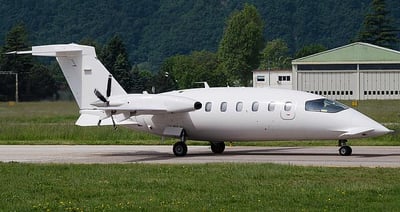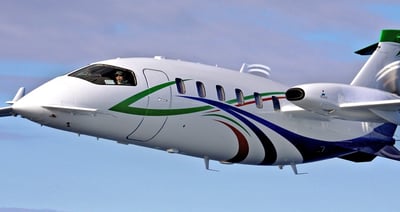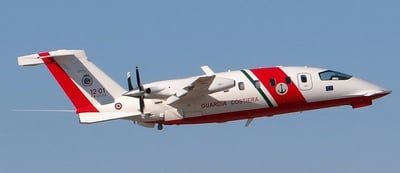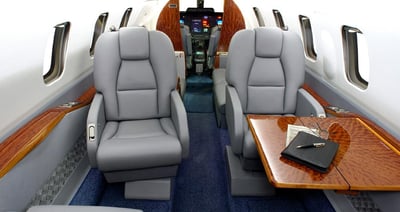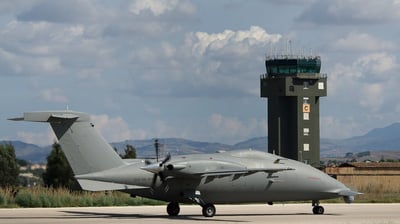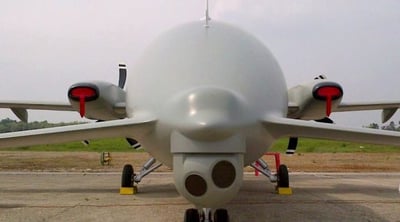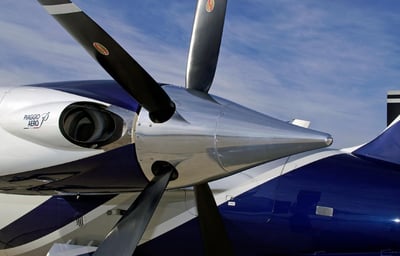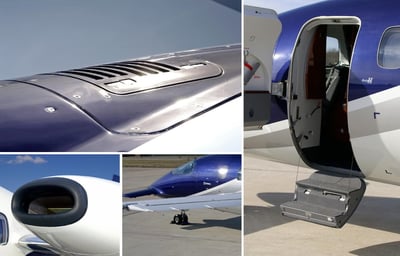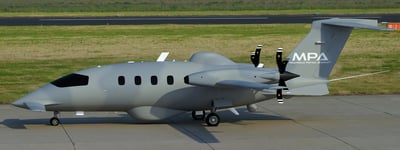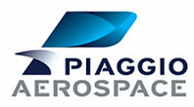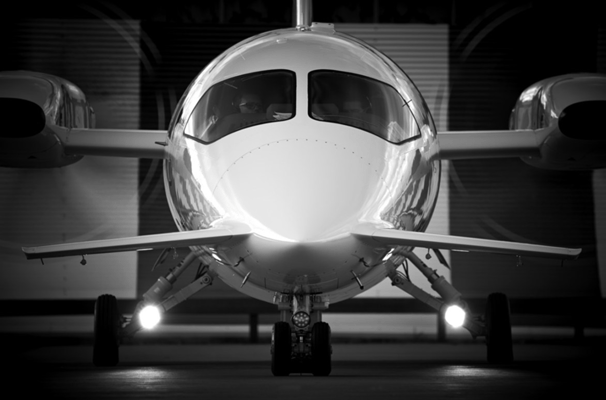

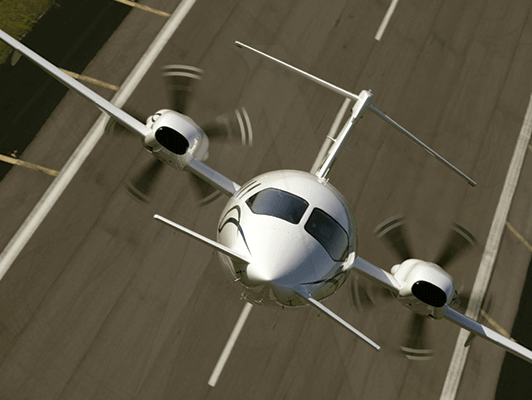

The PIAGGIO P.180 Avanti EVO is a pressurized, twin-engine, three-lifting surfaces, pusher propellers, and turbine-powered aircraft capable of carrying up to 10 people (including crew)depending on interior configuration and the selection of options. The Avanti EVO is the latest evolution of an aviation legend, built on the P180 platform combining the best of "Made in Italy" style, attention to detail and the performance of a high-tech aircraft.
Thanks to the extended range, better climbing performance, lower consumption and an even more elegant and luxurious cabin, the Avanti EVO is an outstanding aircraft in its category.
It achieves speed performances without compromising operating costs, running at up to 30% less than a jet of the same size and boasting a support program that keeps maintenance costs at a rate guaranteed by the manufacturer.
In addition, through its unique design features, speed and modern technology platform, the Avanti EVO delivers over 30% more aerodynamic efficiency than conventional aircraft which creates a far greener footprint resulting in the lowest CO2 emissions in its category.
The Avanti EVO sleek, instantly recognizable lines accommodate a remarkably spacious whisper-quiet cabin, offering passengers broadband and satellite connectivity, greater comfort and working space than any other aircraft of its kind on the market.
Able to accommodate up to seven passengers plus two pilots and with a max range of 2944 Km (1590 nm), the Avanti EVO is ideal for any continental destination while its ability to land on short runways allows access to peripheral airports and smaller airfields not served by scheduled flights.
Avanti EVO, faster than conventional turboprops, offers the best combination of performance, comfort and efficiency compared to any other business aircraft available today.
The aircraft complies with the requirements of EASA CS-23 and of FAR Part 23. It has been certified by the Authorities of the European Union, United States, Canada, and other countries in the transport category including day, night, VFR, IFR operations and flight into known icing conditions.
The P.180 Avanti EVO complies with RVSM operation requirements and is approved for Cat. II approach and landing operations and for steep approaches.
The Avanti EVO is designed to provide jet-like speed on turboprop fuel flows, as well as the spaciousness and comfort of a wide-body, stand-up cabin. Key to the Avanti EVO's speed and efficiency are the three lifting surface configurations and no aerodynamic compromise.
A low-drag airfoil for the main wing is designed applying a NASA-developed methodology, taking advantage of the pusher configuration's undisturbed airflow over the main wing to enhance laminarity. Laminar flow over 50% of the wing chord is achieved, which compares to a maximum of 20% of the wing chord normally obtained on tractor-type propeller aircraft.
The Avanti EVO's forward wing is a fixed lifting surface which has flaps that move in concert with the main wing flaps. The forward wing pitch angle is set to stall before the main wing, producing an automatic nose-down effect; its five-degree negative dihedral keeps the stream wash interference clear of the engine inlets, the main wing, and the stabilizer. The global effect of the three lifting surfaces in the Avanti EVO allows some 34% main wing area reduction, hence a proportional benefit in weight and drag.
To improve overall performance, the P.180 Avanti EVO is equipped with winglets and new forward wing tips, perfectly integrated into the original yet advanced aerodynamic design.
Pitch and yaw control are through a traditional T-tail arrangement and lateral control through ailerons, thus providing fully conventional handling characteristics. All controls are fully manual and aerodynamically balanced for lightness, and the ailerons have completely sealed gaps. All three axes have electrically - powered trim tabs.
The airframe consists of 90% per cent aluminum alloy and 10% composite construction. The engineer’s objective was to concentrate the primary stress from the wing, landing gear and aft pressurization bulkhead on the “structural core” of the aircraft. This allowed a noticeable weight saving in that area since the same structure supports different loads at different times.
A variable cross-section streamlined fuselage is developed to obtain both efficiency and the greatest possible interior volume. The fuselage is a monocoque structure made of conventional aluminum alloy, produced through an innovative, "outside-in" construction process, whereby large skin panels are held in place by vacuum pressure as the internal structure is riveted into place.
The result is a fuselage built to extremely close external tolerances, thus minimizing drag due to imperfections.
Composite materials are used in areas requiring maximum stiffness with minimum weight, such as the stabilizer, and in areas with intricate complex surfaces such as the engine nacelles or the winglets.
The turboprop engines are fitted with inertial particle separators and installed as pushers in low-drag, area-ruled nacelles.
Avanti EVO is designed to minimize the impact on the environment, significantly reducing community noise levels close to 1/2 of the Avanti & Avanti II acoustic power.
This ambitious goal is obtained with a new propeller arrangement made with a state-of-the-art pusher propeller with scimitar blades rotating at lower rpm coupled with proprietary exhaust “shark gills” ducts that optimize hot gases impact on blades & hub and at the same time improve thrust in cruise while reducing community noise at takeoff & landing.
As a side benefit, the new propeller arrangement provides a slight improvement to the already best-in-class internal noise levels.
The five-bladed counter-rotating scimitar propellers do not need any anti-ice system since are naturally heated by the exhaust gases.
Avanti EVO is designed to incorporate a state-of-the-art digital Environmental Control System that provides a fully automatic, dual-zone, integrated bleed air heating and vapour cycle cooling system; automatically managing cabin and cockpit temperatures.
As an additional improvement, the new digital ECS has an increased cooling power to reduce cool-down time in hot weather.
The ECS package is located completely below the baggage compartment floor, thus improving the everyday use of the available volume.
To improve efficiency and reliability Avanti EVO has been equipped with a state-of-the-art, powerful LED TAXI & LANDING light system, that achieves a light service life two orders of magnitude greater than current technology. Avanti EVO incorporates a brand-new landing gear system that is designed to maintain and improve aircraft performance and at the same time significantly reduce life cycle costs.
The nose gear is equipped with a SAE Class B steering system, providing full-time use during T/O & Landing with automatic engagement/disengagement; the steering system technology used on Avanti EVO is at the state of the art for business aviation and is derived from best-in-class applications.
To provide the best possible flexibility for a variety of customer needs, Avanti EVO may include in its configuration an additional fuel tank, placed in lieu of a toilet cabinet that brings the max range up to 1,590 nm. The additional fuel tank operation is designed to be transparent to ground and flight crew.
Aiming at further operational capability, Avanti EVO may include in its configuration an advanced Anti-Skid system to improve ground handling qualities and reduce pilot workload.
Based on the same platform P180, the models P1HH and MPA were developed, which find their application in the defence sector.
The Piaggio Aerospace P.1HH HammerHead is a new, state-of-the-art Unmanned Aerial System (UAS) designed for Intelligence, Surveillance and Reconnaissance (ISR) missions whose combination of performance and operational characteristics is at the very top end of the UAS MALE category.
The Piaggio Aerospace MPA – Multirole Patrol Aircraft – is a technologically advanced, efficient and competitive Special Mission, Multi-Role, Enforcement light twin turboprop aircraft designed to meet the requirement for security and enforcement missions in peacekeeping operations to real combat scenarios with the advanced performance and best in class operational characteristics, comparable to those required by the most demanding operators in this category.
